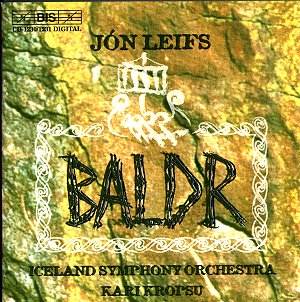To date This ninety minute work is the most ambitious
of the Leifs scores to be tackled by BIS. It has been recorded before
on the CP² label (probably not easily accessible now). There the conductor
was Paul Zukofsky (better known to some of you as a violinist with a
passionate commitment to contemporary works - his DG William Schuman
Violin Concerto is worth seeking out.). Zukofsky has conducted many
of Leifs' works and several of his recordings can be found in the catalogue
of the Iceland Music Information Centre (have a look at their website).
Zukofsky conducted the first full concert performance of Baldr in
1991 with the Icelandic Youth Orchestra.
The fact that Leifs lived in Germany during the 1930s
and 1940s and had a fascination with Nordic mythology, the sagas and
eddas, might lead you to believe that here was a hero of the Nazi state.
You would be wrong. Leifs found the NSDAP cultural sympathisers’ appropriation
of Scandinavian mythology quite odious. His primitivistic music, rootedly
tonal but deploying dissonance borne out of elemental violence (derived
from Rite of Spring) did not endear him to the Hitlerian state.
His wife was Jewish and he found his work banned. The couple fled to
Sweden and thence the composer returned to Iceland. Only two scenes
of Baldr were completed in Germany. During the writing Baldr
Leifs’ life was shredded by a bitter divorce, by rumours of Nazi sympathies
and by the death of his youngest daughter in Sweden in 1947.
The plot of Baldr can be summarised as the struggle
between good and evil each personified by Baldr and Loki. The two acts
are separated by fifteen years. In the first Act the Icelandic creation
epic is played out. The tragic second act establishes a parallel with
the Trojan legends when Baldr is case-hardened against death from various
natural sources. Mysteriously ivy is rejected and of course the evil
and envious Loki, who prizes Nanna (Baldr’s ‘eve’) for his own, slays
Baldr with an ivy spear. Loki is finally punished strapped to a cliff
face with a bowl of poison above his head. At the close of the work
the voice of Óðin rings out prophesying that Baldr will return.
The curtain falls with the audience surely wondering about Baldr's proximity
to Christ and even to Enkidu (in the Gilgamesh legend).
The music is squat, swarthy and uncompromising. Great
thunder-tread steps, often off-beat and dissolute, rend the landscape.
Leifs liberally deploys a vast array of percussion including rocks,
metal chains, cannons, pistols and anvils. I must not give the impression
that the music is an unremitting round of fury and angular sound. There
is much quiet music as well and a sort of modernised Grieg-like dance
appears from time to time (for example the all grace and smiles in Nanna
- Baldr's beloved). Other resonances and coincidences include the
wildly unbridled xylophone solo from Havergal Brian's Gothic Symphony,
a touch of the whirling hell-furnaces of Tchaikovsky's Francesca
da Rimini, Prokofievian gawkiness in The Wedding, Copland-like
pastoralism (yet with a certain chilliness) and a Beethovenian stomp
as in the dionysian impacts of the Seventh Symphony (try Act II The
Throwing Game). There is very little singing and in the five episodes
where it does appear it is brief. The voices are used as part of the
effect in vocalising ululation and slides in the Dance of the Creatures
of the Earth. The final Volcanic Eruption and Atonement is
Leifs' pioneering essay in portrayal of the explosive forces of nature.
It is here that anvils, stones, chains and thunderous assaults are most
in evidence. This furious vehemence was to be followed by much more
familiar (or less unfamiliar) later works such as Geysir, Hafis,
Hekla and Dettifoss. The movement was surely inspired
by the eruption of Mount Hekla in March 1947.
The notes are typically excellent. They are written
by Árni Heimir Ingólfsson. Good to see that the quadrilingual
booklet includes Icelandic. You would be surprised if Bis had not included
all the sung texts and translations. You will not be surprised! Design
choices throughout show Bis's sound taste and judgement. The two discs
are housed in a single-width case.
Next we must hope that Bis and perhaps IMIC will be
prepared to invest in recording the massive Edda trilogy. Perhaps
after that someone will suggest that a composer of insight and sympathy
such as John Pickard or Rodney Stephen Newton should be commissioned
to orchestrate Havergal Brian's great epic Prometheus Unbound (soli,
chorus and orchestra) and then to record it. The full score of the Brian
seems to have vanished without trace.
Bis are building a (I should say 'the', for there is
no competition at all) Leifs Edition paralleling their work in progress
for Skalkottas. Such is Bis’s expansive confidence that they do not
even list the other discs in the Leifs Edition in the insert booklet.
The Iceland SO have been a constant in the series but the conductor
Kari Kropsu is a new name at least in this context. I trust that it
will not be the last time we hear from him.
This is tough, tonal, uncompromising music, rhythmically
emphatic, not without melodic softness, hewn out of granite and adversity.
Perhaps not the place to start your Leifs pilgrimage.
Rob Barnett
NOTE
The movements, scenes or episodes (each separately banded) are:
Act I (CD1)
Dance of the creatures of the earth
The Creation of Man
Nanna
Hurricane
The Chosen Warriors
The Wedding
Dance-Finale
Act II (CD2)
Baldr's Dreams
The Oathtaking
The Throwing Game
Baldr's Death
Baldr's Cremation
Volcanic Eruption and Atonement


